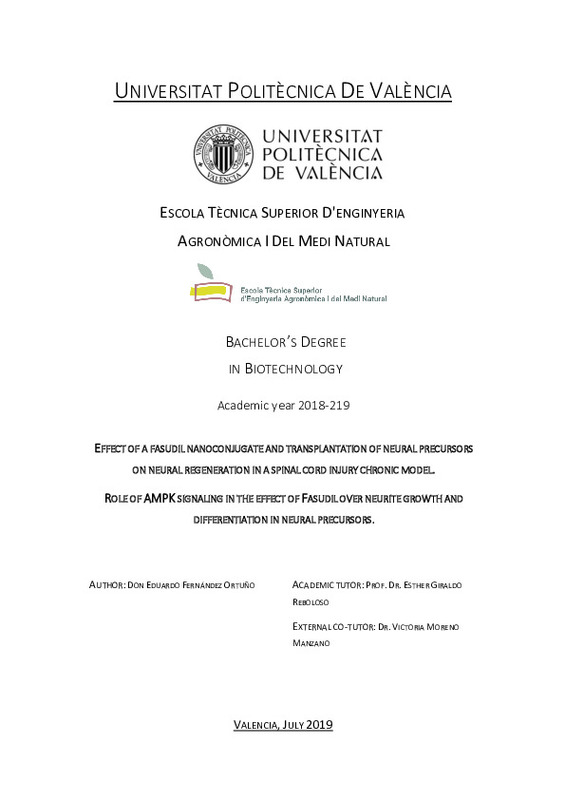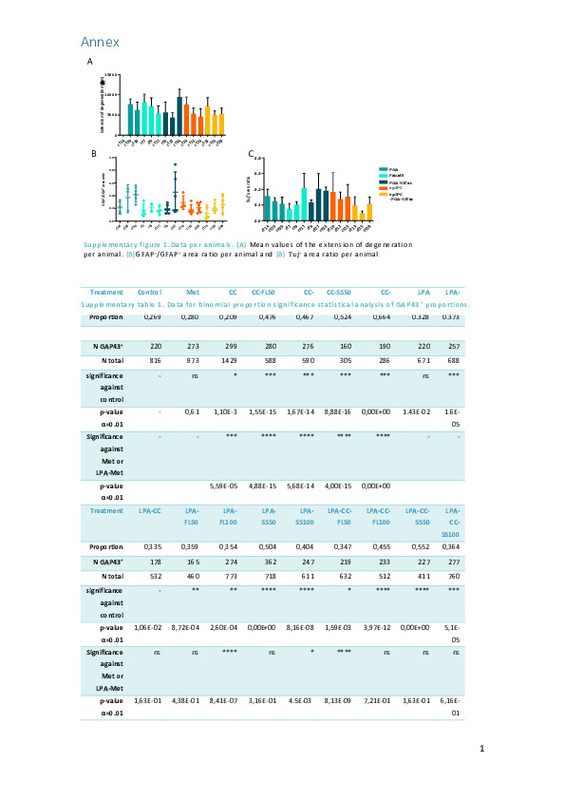|
Resumen:
|
[ES] A pesar del potencial regenerativo de precursores neurales y de la capacidad de remodelación axonal
y sináptica, la lesión medular (LM) se mantiene sin cura y como uno de los traumatismos con
consecuencias más ...[+]
[ES] A pesar del potencial regenerativo de precursores neurales y de la capacidad de remodelación axonal
y sináptica, la lesión medular (LM) se mantiene sin cura y como uno de los traumatismos con
consecuencias más drásticas para la calidad de vida de los afectados. Distintas estrategias se están
desarrollando para modular el microambiente de la lesión. En este punto, la terapia celular con
precursores neurales ependimarios se ha consolidado como una de las puntas de lanza en la
consecución de una terapia efectiva para la LM. El trasplante de precursores neurales epSPCs
(ependymal stem/progenitor cells) en el tejido lesionado se realiza con dos objetivos: que induzcan
una modificación del microambiente que reduzca las barreras a la regeneración o que la promueva,
así como que logren integrarse y formar parte del tejido nervioso, fortaleciendo la recuperación
funcional.
Por otro lado, después de una LM, la remodelización sináptica y la reorganización del circuito axonal
puede ser implementada mediante la modulación de señalización inhibitoria o aumentando el
potencial de crecimiento intrínseco de las neuronas. Uno de los mecanismos moleculares para la
estimulación del crecimiento neuronal asentados es la inhibición de la vía de señalización Rho/ROCK.
El compuesto Fasudil inhibe esta vía y su aplicación ya ha sido relacionada con la regeneración
neuronal en este sentido. Para una mejor acción prolongada del fármaco, este ha sido conjugado con
un polímero de poliglutamato que le proporciona una mayor estabilidad en el tejido, permitiendo
una liberación continuada durante un mayor tiempo, lo que se espera que tenga un mejor efecto en
la regeneración tisular.
Teniendo esto en cuenta, una terapia combinatoria con precursores neurales y Fasudil podría tener
un efecto sinérgico sobre la recuperación del tejido lesionado en la médula. En este trabajo se analiza
en un modelo de LM crónico en rata el efecto de distintos tratamientos que combinan estos factores.
No obstante, los efectos neuroprotectores y neurorregeneradores del Fasudil no han sido
completamente caracterizados y podría haber otras vías de señalización implicadas. En este ámbito,
el regulador del balance energético celular AMPK ha sido relacionado con neuroprotección y
crecimiento axonal. Por ello, para tratar de dilucidar una posible interacción del Fasudil en esta vía,
también se estudian los efectos sobre el crecimiento de neuritas y la diferenciación en epSPCs
sometidas a tratamientos con Fasudil, con un activador de AMPK (metformina) y con un inhibidor (el
compuesto C).
[-]
[EN] Despite the regenerative potential of neural precursors and the axonal and synaptic remodeling capacity, it has not been possible to find effective means of cure for spinal cord injury (SCI) and it remains as one of ...[+]
[EN] Despite the regenerative potential of neural precursors and the axonal and synaptic remodeling capacity, it has not been possible to find effective means of cure for spinal cord injury (SCI) and it remains as one of the traumatisms having most drastic consequences for the quality of life of those being affected. Several approaches are under development in order to manipulate the lesion microenvironment. At this regard, cell therapy with ependymal neural precursors is considered as one of the spearheading strategies for the consecution of an effective treatment for SCI. Transfer of neural precursors epSPCs (ependymal stem/progenitor cells) into the injured tissue aims at two objectives: a modification of the microenvironment, which could either boost the process of tissue regeneration or limit its barriers; as well as their integration in the nervous tissue, which is expected to strengthen the functional recuperation.
Additionally, after a SCI, synaptic remodeling and axonal circuit reorganization could be implemented via the modification of inhibitory signaling pathways or increasing the intrinsic growing potential of neurons. Inhibition of the Rho/ROCK signaling pathway is one of the molecular mechanisms known to stimulate neural growth. In this sense, Fasudil is a compound that inhibits this pathway and its application has been related with neural regeneration. So as to attain a longer action of this drug, it has been conjugated with a polyglutamate polymer, which confers it a higher stability in the tissue, allowing a more distended and continuous release for a more extended time, which is expected to elicit a better response for the regeneration of the tissue.
Taking this into consideration, a combinatory therapy involving neural precursors and Fasudil could have a synergic effect on the recuperation of the injured tissue in the spinal cord. Along the present project, the effect of different treatments combining these factors are analyzed in a rat chronic model of SCI.
Notwithstanding, Fasudil neuroprotective and neuroregenerative effects have not been completely characterized and there could be other signaling pathways being implied. The cell energetic balance regulator AMPK has been associated with neuroprotection and axonal growth. As such, in order to elucidate a possible interaction between Fasudil and this pathway, the effects of several treatments comprising Fasudil, an AMPK activator (metformin) and an AMPK inhibitor (compound C) on neurite growth and differentiation of epSPCs are studied as well.
[-]
|











